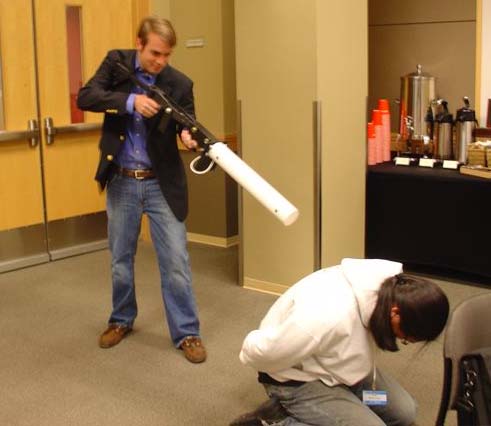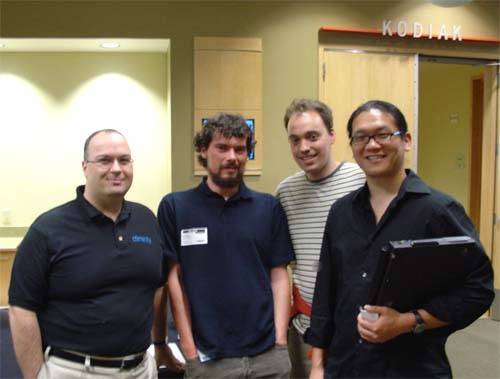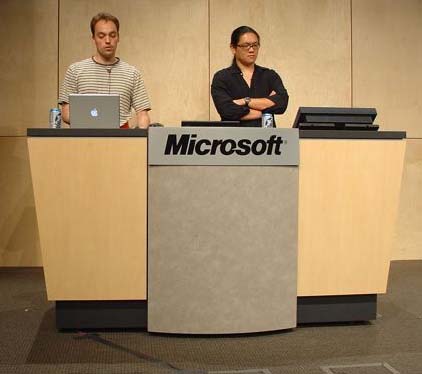I was at FOO camp last weekend and it was a blast. As usual, Tim brought together quite an interesting crowd of people. It was a pleasant surprise to see old friends from MIT, some whom I hadn’t seen in years. To date, four FOO alumni worked on the same robotics team (ORCA) building autonomous submarines at MIT back when we were all students there, and at least three students/ra’s of my MIT graduate advisor, Tom Knight, have also attended FOO. Of course, I got to meet some interesting new people, including a group of folks who have expertise and great interest in manufacturing in China (we had a little round table discussion about doing business in China and China’s economic role in the world). I also gave a little presentation about how chumbys are made in China, something which I will blog about in the next couple of days through a set of posts forthcoming (I have a lot of material to go through so it’s taking me a while to organize them and write them).
One FOO attendee who I was most fortunate to stumble upon was Christine Smolke. She gave a fascinating talk about the capabilities of RNA that really opened my mind. As many may be aware, the “central dogma” of biology is being rewritten, and RNA is starting to take a more active role in everything from heredity of genetic traits to catalysis of reactions. Recent findings have caused some hypotheses to be revisited, such as the “RNA world” hypothesis, which indicate that life may actually have started through self-replicating strands of RNA, instead of DNA.
The most interesting connection I made listening to her talk was with my experience looking at the protein folding problem. In a nutshell, protein folding is one of the “grand challenges” of computer science today, and the basic mission is to predict the 3-D structure of a protein given its amino acid sequence–in my opinion, one important part of the “uber-tool” for nanotechnology engineers that would create a catalyst for an arbitrary substrate (another application for protein folding is also to elucidate the structure of proteins that cannot be crystallized and are thus unsuitable for X-ray diffraction analysis).
Protein folding is hard. I mean, really hard. It’s one of the few computational problems that truly scare me. There are whole supercomputer projects devoted to the subject, from DE Shaw’s ambitious project to IBM’s Blue Gene series of machines, to Stanford’s Folding at Home distributed computing project. My facts are a couple years out of date but iirc, a typical goal for such a big project would be to fold one “small-ish” protein of about 50 to 100 amino acids in about a month–a reaction that happens in a cell on a timescale on the order of milliseconds. And, the problem doesn’t scale particularly well. The reasons why protein folding is hard are numerous, and most of them have to do with the enormous dynamic range of timescales required for the simulation, the very sensitive interactions that the numerous hydrophilic and hydrophobic amino acids have with the surrounding water, and the sheer number of particles involved. The simplifying assumptions made in even the most sophisticated simulations today are crude compared to the actual conditions in the cell. The way a protein folds depends upon the rate of sequence output, the temperature, pH conditions, presence of helper molecules, coordinating ions, and even post-folding sequence modifications–all things that challenge current computational models.
To illustrate the point, even the iconic double-helix of DNA is a direct result of its interaction with its surroundings. The double helix arises from the fact that the base pairs are “greasy” (hydrophobic) and they repel water, so they stick together…thus, a structure that might otherwise look like a straight ladder collapses in on itself to minimize the distance between the rungs, squeezing out the water, and in the process twisting the backbone into a double helix; the process also requires coordinating ions from the water to neutralize the concentration of charges brought on by the collapse into the double-helix. Before I learned about this I just took the twisting of DNA for granted…shows how little I know about the real mechanics of biochemistry, but boy, is it fascinating.
Christine’s talk on RNA got me thinking…RNA is nice, as it can function single-stranded, and is very pliable. It only has four base pairs, instead of the twenty basic amino acids found in proteins. The secondary structure of an RNA molecule is also predictable. And, RNA can be active on a variety of substrates. Granted, RNA may not be as effective, efficient, or as versatile as the more complex protein counterparts, but I can’t help but wonder if maybe a good baby-step would be to first try to solve the RNA folding problem. It’s only a hunch right now but it feels like RNA might be an easier beast to tame than proteins. And as a molecular tinkerer, I’d rather have a tool that creates less than optimal results but is available sooner, can iterate faster, and is more affordable, instead of a tool that gives ultimate results but also comes at enormous cost and effort. There are a lot of simple molecular problems that need solutions today, and perhaps from these learnings we can eventually develop smarter tools for the more complex problems.
Ah, if only I had the time and the money…too many interesting things to do! I wonder if I had become a professor instead of a professional, if I would have had the priviledge to investigate such interesting diversions, or if I would simply be consumed by the tenure clock…


